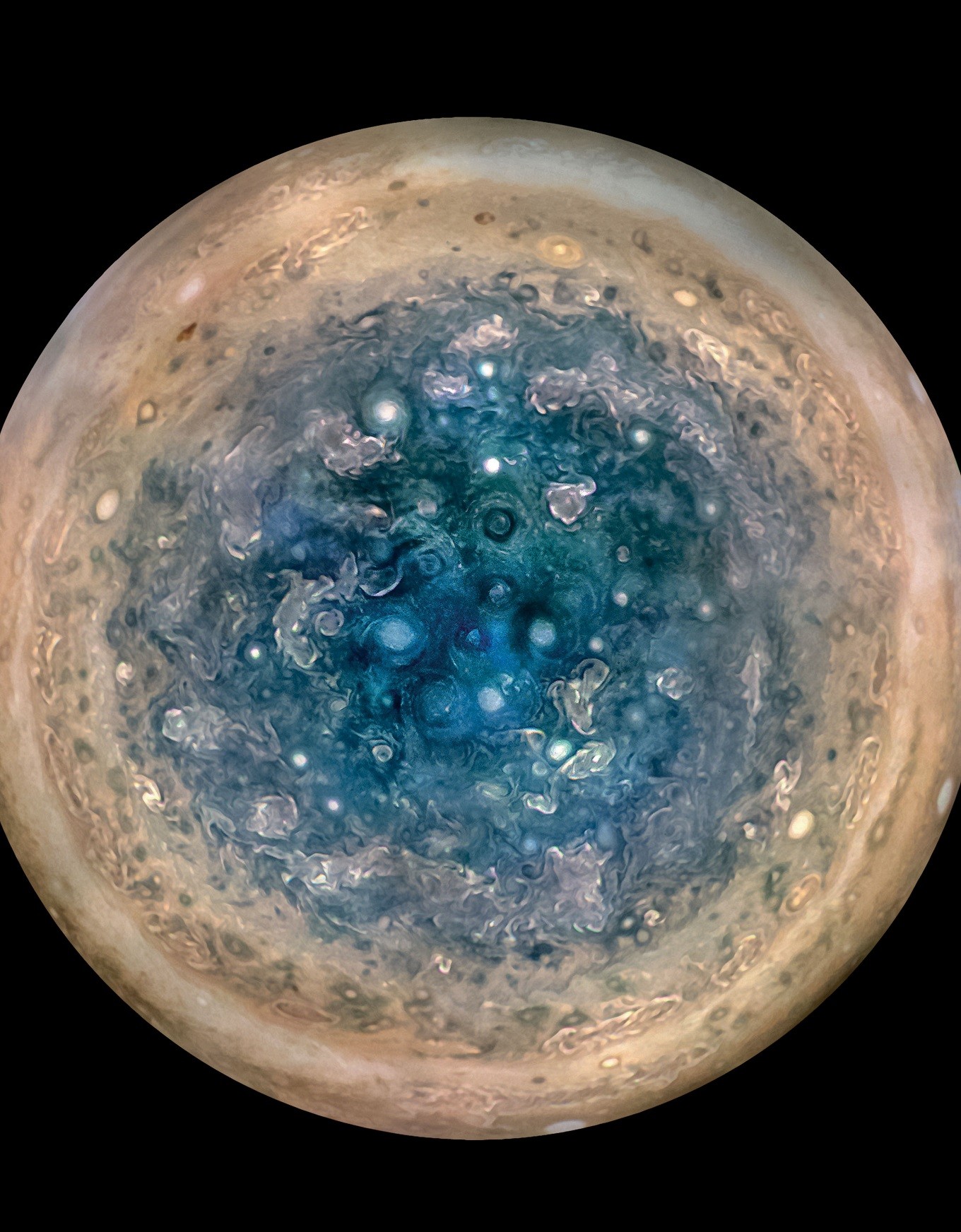Popular Reads
Top Results
Can't find what you're looking for?
View all search resultsPopular Reads
Top Results
Can't find what you're looking for?
View all search resultsNASA's Juno probe forces 'rethink' on Jupiter
Change text size
Gift Premium Articles
to Anyone
 This NASA handout image released May 25, 2017 shows Jupiter’s south pole, as seen by NASA’s Juno spacecraft from an altitude of 32,000 miles (52,000 kilometers).
The oval features are cyclones, up to 600 miles (1,000 kilometers) in diameter. Multiple images taken with the JunoCam instrument on three separate orbits were combined to show all areas in daylight, enhanced color, and stereographic projection.Early science results from NASA’s Juno mission to Jupiter portray the largest planet in our solar system as a complex, gigantic, turbulent world, with Earth-sized polar cyclones, plunging storm systems that travel deep into the heart of the gas giant, and a mammoth, lumpy magnetic field that may indicate it was generated closer to the planet’s surface than previously thought. (Handout / NASA/JPL-CALTECH/SWRI/MSSS / AFP/File)
This NASA handout image released May 25, 2017 shows Jupiter’s south pole, as seen by NASA’s Juno spacecraft from an altitude of 32,000 miles (52,000 kilometers).
The oval features are cyclones, up to 600 miles (1,000 kilometers) in diameter. Multiple images taken with the JunoCam instrument on three separate orbits were combined to show all areas in daylight, enhanced color, and stereographic projection.Early science results from NASA’s Juno mission to Jupiter portray the largest planet in our solar system as a complex, gigantic, turbulent world, with Earth-sized polar cyclones, plunging storm systems that travel deep into the heart of the gas giant, and a mammoth, lumpy magnetic field that may indicate it was generated closer to the planet’s surface than previously thought. (Handout / NASA/JPL-CALTECH/SWRI/MSSS / AFP/File)
A
n unmanned NASA spaceship circling Jupiter has spotted massive cyclones at the gas giant's poles, revealing stunning new details about our solar system's largest planet, researchers said Thursday.
A NASA statement described the planet as "a complex, gigantic, turbulent world" that is far different than scientists previously thought.
Two papers in the journal Science and 44 papers in Geophysical Research Letters describe a trove of discoveries made since Juno began orbiting Jupiter last year.
"We knew, going in, that Jupiter would throw us some curves," said Scott Bolton, Juno principal investigator from the Southwest Research Institute in San Antonio.
"There is so much going on here that we didn't expect that we have had to take a step back and begin to rethink of this as a whole new Jupiter."
A look at Jupiter's poles has shown they are covered with dozens of densely clustered storms, possibly dropping hail or snow.
"Images of Jupiter's previously-unseen poles show a chaotic scene of bright oval features," said one of the studies in the journal Science.
These ovals, it turns out, are huge swirling storms, some of which measure up to 870 miles (1,400 kilometers) across.
Researchers found "signs of ammonia welling up from the deep atmosphere and forming giant weather systems."
Now, more study is needed to better understand the nature of Jupiter's storms, and why the planet acts this way.
Read also: Humans need to leave Earth soon, according to Stephen Hawking
- Juno mission -
The solar-powered Juno spacecraft launched in 2011, and made its first tour around Jupiter on August 27, 2016.
Juno moves in an elliptical orbit, skimming within 3,100 miles (5,000 kilometers) of Jupiter's cloud tops and passing over the poles.
Juno's mission is scheduled to end in February 2018, when the probe will self-destruct by diving into the planet's atmosphere.
The $1.1 billion project aims to peer beneath the clouds around Jupiter for the first time to learn more about the planet's atmosphere and how much water the planet contains.
"On our next flyby on July 11, we will fly directly over one of the most iconic features in the entire solar system -- one that every school kid knows -- Jupiter's Great Red Spot," said Bolton.
"If anybody is going to get to the bottom of what is going on below those mammoth swirling crimson cloud tops, it's Juno and her cloud-piercing science instruments."
Read also: Earth’s newfound ‘twin’ is an ice ball planet, says NASA
- 10x Earth's magnetic field -
Juno has also taken measurements of Jupiter's gravitational field, to see if it has a solid core, as some models have predicted, or no core at all.
Instead, researchers found that the core is "fuzzy," -- neither a small compact core nor a non-existent core.
Bolton said the core may be partially dissolved, and is certainly much larger than anybody had anticipated.
Even before Juno launched, researchers knew Jupiter had the most intense magnetic field in the solar system.
But now, astronomers see that it is "substantially stronger than models predicted, at 7.766 Gauss, or roughly ten times Earth's magnetic field," said the study.
According to Jack Connerney, Juno deputy principal investigator and the lead for the mission's magnetic field investigation at NASA, the "magnetic field looks lumpy.
"It is stronger in some places and weaker in others," he said.
"Every flyby we execute gets us closer to determining where and how Jupiter's dynamo works."










